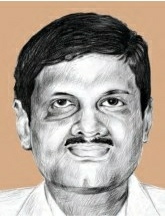Cafemutual starts a series of interviews with the game-changers who have shaped India’s MF industry. In this interview, we feature V Shankar, Director, CAMS, who entered the challenging R&T business when mutual funds were still in their infancy in the country.
 You worked with Pond’s as a Sales Manager. How did the transition to IT happen? What made you shift your focus?
You worked with Pond’s as a Sales Manager. How did the transition to IT happen? What made you shift your focus?
I could say that I was a visionary and immediately understood the potential of IT, but that would be facetious. Even as Sales Manager in Pond’s, my interest was in IT, but to an extent you can attribute it to serendipity. Please understand that IT, particularly software, was an exotic and little understood topic then, somewhat like genetic engineering is today. I guess there was simply a good fit between my personality and the demands of IT engineering.
You started CAMS in 1988 as an IT services company and then gradually moved to capital markets and then to mutual funds. How did the idea of floating CAMS come to you?
Though my interest was in the software side of IT, software in those days was considered like the chutney that was given (free) with the idlis. The concept of creating software to one’s particular need and more importantly of paying for it did not arise. At the same time, operating computer hardware was still a somewhat specialist task. Hard disks were 10MB in capacity, the size of a dictionary and very expensive. Employing people was still cheap. The general customer attitude was that if someone was willing to take the effort of investing in a computer, operate it, and produce a result cheaply that was fine, otherwise the customer would just employ more staff to do the work manually.
In this scenario, the only real market opportunity was to produce an outcome rather than deliver software. That opportunity for creating an outcome turned out to be data processing for the capital market industry as it was crying for a professional touch.
How did you get your first client? How did you manage to bag the accounts of most fund houses?
CAMS had several Chennai-based clients in the very beginning. This may have been because capital market vendors were mainly based in Mumbai in those days and communication was not as easy then as it is nowadays. A Chennai-based alternative was attractive for simple logistical considerations. However, once we established a track record, customers from all over India came to us because we rapidly built a reputation for integrity and efficiency.
The first large mutual fund account we signed on was that of Alliance Capital Mutual Fund. We were very fortunate in having them as our first client, as they helped us tremendously in many operational aspects of what was then a nascent industry. In fact, we set up a JV with them, Acsys Software, to develop software for the AMC industry.
We have been fortunate to get a number of AMC clients. I attribute it to our single-minded focus on the development of not only our side of the industry, but also in the growth of asset management itself in India. Like the early AMCs, we were category creators.
The Indian mutual fund industry has two dominant registrars who cater to a large section of the trade. Has the limited competition in the R&T space helped you?
When the MF R&TA industry started its journey, it had almost eight RTAs including certain marquee names like Citi, etc. What differentiated CAMS was:
(a) An unflinching commitment to the MF industry. We vacated the equity R&TA business almost two decades back and did not consciously enter any segment which would put us in a conflict situation. Our MF RTA value proposition brought the difference through scale and specialisation benefits;
(b) A stream of product/process innovations like Active Statement, MFDex, Fundsnet, etc;
(c) Continuous investment behind technology and front-office infrastructure to increase reach and grow the assets.
All these factors sharpened our competitive advantage and led to a two-player situation and not the other way round.
I believe that in infrastructure plays like exchanges, depositories, and institutions like ours (a combination of the two), players need scale to deliver economies and efficiency. Too many players will dilute scale and investment ability to the ultimate detriment of society.
How have your systems and process evolved since you started? What new technologies and processes have you deployed over the years?
In the initial stages, we had an offline-data model with front offices not having access to the core system on a live basis. Front offices used to carry out limited data entry required for processing the transaction and send the physical copies by courier. Web-enabled browser based technology was introduced in the late ‘90s, once connectivity became affordable, and this allowed our front offices and clients to access data on a real-time basis.
Image-based processing was introduced in 2000 which led to qualitative change in the speed and manner with which we processed a transaction. We could despatch account statements within three days as against the earlier norm of 10 days. Workflow-based processing was introduced in 2005, significantly enhancing the speed while ensuring control.
Today most of our clients’ CRMs are powered by our replication tool which enables the AMCs to respond to investor queries on an instantaneous basis.
We constantly add value to our clients through product/process innovations, which has resulted in better services to investors and distributors while bringing down the cost. A few such innovations are:
- MFDex, a Business Intelligence tool;
- eSTR, a tool to identify and report transactions which require investigation for compliance with Prevention of Money Laundering Act;
- Active Statement, first of its kind, providing a single view of the investments held across the participating mutual funds. It also allows investors to interact with it, showing charts, accepting service requests, updating static information etc. CAMS was the original innovator of the Common Accounts Statement bringing convenience to investors and cost efficiency to AMCs.
Our role has evolved from that of a service provider to a knowledge partner and business enabler, boosted by our extensive domain knowledge. We enable growth of the industry through our reach, physical and electronic. Our electronic platform, Fundsnet, has enabled IFAs who are located in Tier-III & Tier-IV cities to participate in the MF industry with the assurance of same day NAV.
How do you make sure that investor data is secure and confidential?
CAMS is ISO 9001:2008 certified for process excellence and ISO 27001 certified for Information Security practices. The spirit of ISO 27001 Information Security standards is that Information Security should be built into the very DNA of the organisation, i.e., in the hiring, induction, training, physical access, data access, application and network security etc., from the design stage itself. CAMS does indeed do exactly that.
Data confidentiality is ensured through multiple levels of control. Who can access what data is documented, implemented and audited for verification of the efficacy of the control systems. Access to all our systems is password protected. Information that may be accessed by an employee is based on the need for access, thus restricting the data to which she has access. For instance, an employee working in X unit will not have access to data of other units, irrespective of his level. Within the unit, the access rights are layered depending on the role/work level. Audit trail is detailed and covers even a simple view access. Data transmission and access are secured and encrypted.
Data centres are protected against physical/electronic intrusion. We have several layers of redundancy built in to protect our data and applications. Our Disaster Recovery & Business Continuity plan are well documented and periodically tested to ensure effectiveness when required. We have both in-city and off city Business Continuity Plan centres.
The R&T business is both manpower and technology driven. How do you manage costs in a challenging environment? What is the differentiating factor in the R&T business? What would be CAMS’s differentiating factor?
All our major cost elements—people, infrastructure and technology—are inflation prone. Despite that, CAMS has delivered cost efficiencies through appropriate use of technology and process innovations. Scale, technology and process innovations have helped CAMS to deliver superior value to mutual funds and investors. CAMS led the initiatives on increasing electronic pay-outs, email communication to investors, Consolidated Account Statements, distributed printing of communication/cheques to reduce postage cost, etc.
Having said that, we are severely challenged now on the cost front, with the industry not growing as it used to earlier, along with inflation running at double digits.
The MF R&TA industry is different from that of the equity market in terms of the sweep of scope, technology and front office infrastructure that is required and the 24/7 demand on the R&TA resources. An MF R&TA manages the entire life-cycle of the investor including acceptance and execution of transactions (which is done by a broker in case of the secondary market), maintenance of records (done by a depository), access and reach (provided by broker and DP), reconciliation/movement of funds (done by broker, Clearing Corporation), processing of dividends (done by the RTA in case of the secondary market) and issuance of account statement done by DP in case of the secondary market) on a platform owned by R&TA (the stock exchange, in case of the secondary market). As can be seen from the above, an MF R&TA performs a role which is holistic and covers the entire spectrum while in case of the secondary market the same is executed by multiple agencies (stock exchange, depository, DP, broker and R&TA). However, the MF R&TA manages to deliver this at a fraction of the cost of that of the secondary market.




